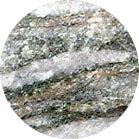Metamorphic rocks
Metamorphism is the alteration of pre-existing rocks in the solid state due to changes in temperature and pressure. Under increasing temperature and / or pressure existing minerals become unstable and break down to form new minerals. In the case of regional metamorphism the rocks are subjected to tectonic forces which provide the necessary mechanisms for metamorphism. Products include schist and slate. Contact metamorphism involves metamorphosis through heating by an intruding plutonic body. Hornfels is the result of this type of metamorphism.
Metamorphic rocks are classified according to the conditions under which they recrystallised, known as their metamorphic facies. The key parameters in this classification are index minerals which indicate particular pressure / temperature conditions. These minerals may only be present in small proportions, and in many cases are difficult to recognise in hand specimen. An alternative classification, useful in the field or for hand specimens, is based upon the degree of recrystallisation of the original minerals, and so grain size and the degree of foliation (see below) are important. As metamorphism occurs in areas undergoing deformation, look also for structures that indicate deformation, such as folding (often shown as crenulations or small crumpled folds), and small fractures or faults.
Metamorphic textures
The two distinctive metamorphic textures are:

Foliation planes in gneiss
Foliation - This represents a distinct plane of weakness in the rock. Foliation is caused by the re-alignment of minerals when they are subjected to high pressure and temperature. Individual minerals align themselves perpendicular to the stress field such that their long axes are in the direction of these planes (which may look like the cleavage planes of minerals). Usually, a series of foliation planes can be seen parallel to each other in the rock. Well developed foliation is characteristic of most metamorphic rocks. Metamorphic rocks often break easily along foliation planes.
Granular - This describes a metamorphic rock consisting of interlocking equant crystals (granules), almost entirely of one mineral. A granular texture is developed if a rock's chemical composition is close to that of a particular mineral. This mineral will crystallise if the rock is subjected to high pressure and temperature. A granular texture is characteristic of some metamorphic rocks.
Note: As the grade of metamorphism increases (more temperature and pressure), both crystal size and the coarseness of foliation increase. Therefore, gneiss represents more intense metamorphism (or a higher grade) than does schist.
Some fine-grained metamorphic rocks, e.g. schist, have larger crystals present. These crystals are called porphyroblasts. Porphyroblasts represent minerals that crystallise at a faster rate than the matrix minerals. Garnet is a common porphyroblast mineral.
| Grain size | |||
| Fine | Medium | Coarse | |
| Poorly foliated | Hornfels | Marble, quartzite | Marble, quartzite |
| Well foliated | Slate | Schist | Gneiss |
| Well foliated and sheared | Mylonite | Mylonite, schist | Augen gneiss |
